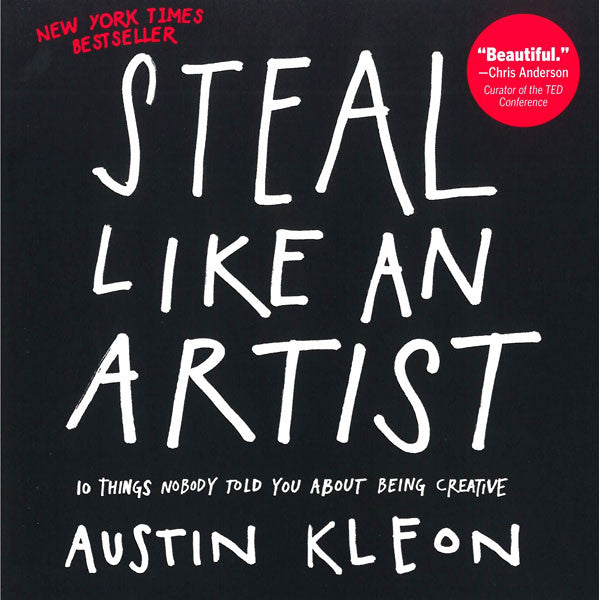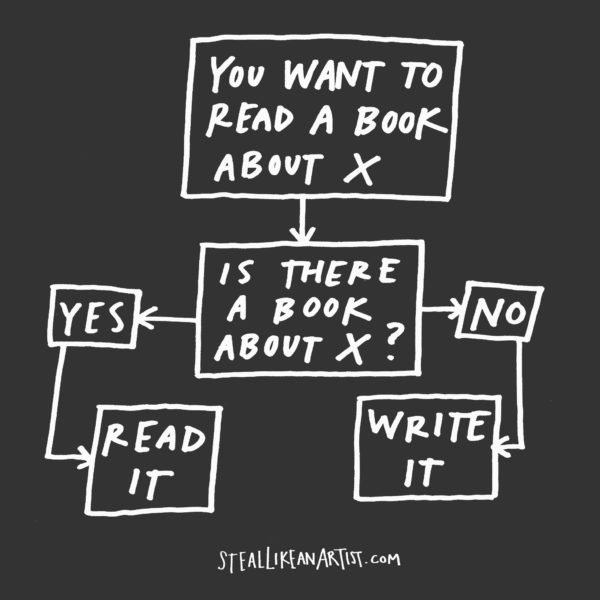If you're gonna be a thief, be a good one.
 As an aspiring artist, I'm always trying to find inspiration and guidance from those who have created before me. That having been said, I don't know if I've ever found a source of inspiration that rang so true as Steal Like an Artist by Austin Kleon.
As an aspiring artist, I'm always trying to find inspiration and guidance from those who have created before me. That having been said, I don't know if I've ever found a source of inspiration that rang so true as Steal Like an Artist by Austin Kleon.This book was an incredibly engaging read and I plan to recommend it to every designer and artist I can; which includes all of you!
I wanted to share a few of my favorite notes I compiled while reading. Many of these notes were taken within the book itself, or strewn between two notebooks and a couple of notecards. While that may seem chaotic, because it is, it fits the natural flow of my daily life. That's how I know the content of this book is so important, it helped me follow my own creative flow regardless of what is 'typical'. But I digress.
Steal like an artist.
Guess what? Nothing is new.
Recognizing this frees an artist from trying to make something out of nothing. Space is a vacuum, and it obliterates things that aren't dense enough. So don't force yourself to forget the work of others in an effort to create something original. Any ideas you might come up with will be so riddled with self-doubt that the vacuum will consume them.
You know that piece you saw that made you a little frustrated? The 'I could have made that' piece? Hold on to it, and push yourself to create and make their own piece better. Prove that you could and SHOULD have made it.
Your experiences compile to create who you are. Denying that is to deny learning, growth, and creativity. So let new experiences in and take note of what you see.
Don't wait until you know who You are to get started.
 Just as compiling new experiences leads us to who we are, creating helps us define what that means.
Just as compiling new experiences leads us to who we are, creating helps us define what that means. Don't be afraid to create something just because you may not know what you're doing. Honestly, nobody knows anything. Art in particular is the ultimate trial and error. Developing your own style and trademark is dependant on this process. You're gonna feel silly. You'll feel like a baby learning to walk all over again. You'll fall. But don't stop. Sketch, doodle, take pictures, do something. MAKE something. Maybe you'll find your niche in something you'd never expected.
Imposter syndrome. It's a very real thing, and it devours potential like nothing else. I won't go too deep into it, but I will say this:
Look at your work. Realize how hard you tried, and listen to the people who are building you up. Allow yourself to take credit for your hard work. Recognize that many people could never do what you just did, and certainly not in the same way. Let yourself learn.
If you're caught on the idea of comparing your work, define who you're using as the ruler. Take those differences and amplify them. Make YOUR work YOUR own.
Write the book you want to read.
 Find your heros, your favorite works, and surpass them. Find the jump scares and colors that feel out of place. Find those moments that make you cringe in an otherwise flawless story. Then fix it. Create the art you want to see in the world, regardless of the medium.
Find your heros, your favorite works, and surpass them. Find the jump scares and colors that feel out of place. Find those moments that make you cringe in an otherwise flawless story. Then fix it. Create the art you want to see in the world, regardless of the medium.
Once you are able to recognize your power to create content that you enjoy, it's only a matter of practice to hone your work (or possibly your audience) to bring others joy too.
Use your hands.
Many artists find themselves stuck behind a computer, always one step removed from their work. This can become a huge drain on the creative process.
It's important not to lose your fire for creation within a screen. Step away and make something tangible. Paint, draw, carve, sculpt, create something. Using your hands to make something helps to fuel your creativity and keep your other projects moving forward.
Nothing on a computer is permanent, and this leads us to abandon our ideas before they are able to fully form. Stepping away can give those same ideas the opportunity to fully mature, possibly becoming exactly what you need.
Side projects and hobbies are important.
Creatives are prone to distraction and procrastination; don't fight it. Allow yourself to be swept into a new activity when your current project becomes dull. But instead of just ignoring your project and never returning to it, try practicing productive procrastination. Switch your focus back and forth between open projects.
I picture this as a game of table tennis, each paddle is a project, and my focus is the ball. I'm not great at focusing, or table tennis if I'm being honest, so I drop the ball pretty often. But when I am able to maintain a bit of a volley, I always feel more productive and accomplished. My ideas flow and my projects are never a chore.
Now these projects don't have to be limited to your required products. And really, they shouldn't be. Stick to your hobbies and loves. If you're a computer animator with a passion for painting, do both. It may not feel 'important', but giving yourself that freedom of unconstrained creation will give far more power to your required creations.
THE SECRET: Do good work and share it with people.
Kleon made a great point about college in chapter six. Your professors are paid to pay attention, and your peers are paying to pay attention. As a college student, you have access to the ultimate captive audience, which is a great way to learn and grow. However, graduation leaves a void that many try to fill by 'making it big'.
Most people who made it big have been dead for a long time, so I wouldn't hang too much hope on being magically discovered. But fear not, because obscurity is the incubator in which bad art is forgotten, and good art thrives.
Instead of feeling lost, allow yourself to embrace the anonymity, then put work into sharing your work. Put in real effort. Then share it every chance you get.
Geography is no longer our master.
 The best part of being an artist today has to be the ease in which you can share your work. There's no need for an expensive gallery when instagram is only a tap away.
The best part of being an artist today has to be the ease in which you can share your work. There's no need for an expensive gallery when instagram is only a tap away.
This also means that it's easier than ever before to connect with other creatives all over the world. So do it! Find people who inspire you, those who have similar values or....I don't need to tell YOU how to use the internet. You've made it this far, I'm sure you're doing alright. (Though if you do want to talk about it, my messages are open!)
Create a space to decompress in. Let your mind wander and do nothing. Wonder about things that seem unimportant. And give yourself new things to ponder.
A goldfish will only grow as large as his tank allows. Your creativity and critical thinking operates in much of the same way. Give yourself room to grow.
Be nice. (The world is a small town.)
Is there someone you can't stand online? Someone who's work appalls you? Ignore them. Let them fade into oblivion, and instead praise those whose work you admire. Share positivity, and lift others up as you network. This applies to both the internet and physical world.
Having such positivity associated with you will boost your reputability and likability. As artists, our reputations are far more important than we tend to give them credit for. Without others to appreciate our creations, what are we?
Speaking of others: find good friends and mentors. Surround yourself with people who inspire you, who appreciate your passions and you can learn from. If you're the smartest person in the room, find a new room.
Be boring.
Be wise; create every day. We all know how it feels to attempt to create after letting your art slip away for a little while. It feels like a chore, and it's because we know it's going to be bad. At least until we get back into the swing of things. Creating a little bit every day will help keep yourself out of that funk, and ready to execute an inspired idea at any point.
It takes a lot of energy to be creative, so chasing a lifestyle that takes away from your creative drive is a horrible waste.
Creativity is subtraction.
 "Kill your children." Phil Mudd, one of my favorite professors (though don't tell him that), tells all of his students this when it comes time for portfolios. What this means is recognizing what needs to be a part of something and what doesn't, regardless of how you might feel in the moment. Giving yourself parameters to work within gives you a clear direction in which to push. This makes for a stronger overall impression in a portfolio or any individual piece.
"Kill your children." Phil Mudd, one of my favorite professors (though don't tell him that), tells all of his students this when it comes time for portfolios. What this means is recognizing what needs to be a part of something and what doesn't, regardless of how you might feel in the moment. Giving yourself parameters to work within gives you a clear direction in which to push. This makes for a stronger overall impression in a portfolio or any individual piece.
Stress yourself out a little. Most all of the greatest recognized artists were lacking something, either in their health, personal lives, or both, and refused to settle into society's prescribed rolls for them.
Take Edgar Allan Poe, for instance. So many of the important women in his life were taken by tuberculosis. And he used the emotional and societal limitations those losses placed on him to drive his writing. He created haunting stories that still inspire people nearly 200 years later.
Don't allow yourself to fall into excuses. Use your limitations to mold your work. Whether those limits are self-imposed, like using specific colors, or something entirely out of your control. Do not accept defeat. Demand success, and you will find it.

Comments
Post a Comment